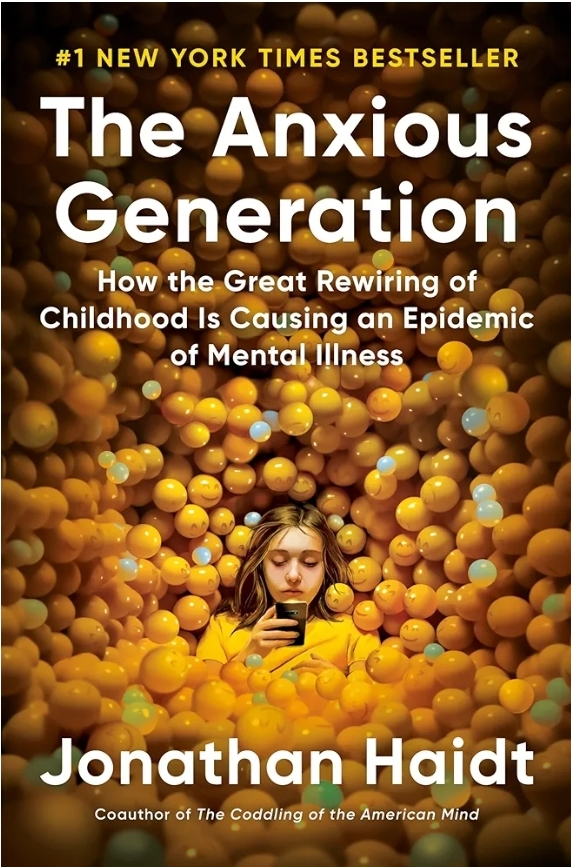Jonathan Haidt’s essay “The Anxious Generation: How the Great Rewiring of Childhood Is Causing an Epidemic of Mental Illness” focuses on the profound changes in childhood experiences and how they have contributed to an alarming rise in mental health issues among young people, particularly anxiety and depression. Here is a detailed summary of the main points:
The Great Rewiring of Childhood
Haidt argues that the rise of smartphones and social media has fundamentally changed the way children grow up, creating a generation that is more anxious, depressed, and socially isolated. He points to several factors as contributing to this “rewiring” of childhood:
- Constant online presence: Social media platforms expose children to social comparison, cyberbullying, and the pressure to constantly manage their online persona.
- Lack of unsupervised play: Unlike previous generations, children today have less freedom to engage in unstructured, unsupervised outdoor play. This limits their ability to develop independence, resilience, and social skills.
- Helicopter parenting: Parents today are more likely to be overprotective, sheltering their children from risk and failure. This has contributed to an increase in emotional fragility and a lack of coping mechanisms.
Epidemic of Mental Illness
Haidt presents data showing a dramatic rise in anxiety and depression among teenagers, particularly girls, which he links to the proliferation of social media use. Girls are more likely to experience social comparison, body image issues, and relational aggression online, all of which contribute to a higher incidence of mental health problems.
The essay explores how this rise in mental illness is not just an individual problem but a societal crisis. The mental health challenges facing today’s youth are overwhelming the healthcare system, and the impact on their future potential is alarming.
Social Media as a Catalyst
Haidt emphasizes that social media is a key factor in the mental health crisis among young people. The constant exposure to likes, comments, and follower counts fuels an unhealthy obsession with social validation. This leads to what Haidt calls “the constant surveillance culture,” where young people are constantly worried about how they are perceived by their peers, which is a source of significant stress and anxiety.
Solutions and Changes
Haidt suggests several strategies to mitigate the crisis:
- Delaying social media access: He advocates for delaying access to social media for children until they are older, suggesting 16 years as a reasonable starting point.
- Encouraging unsupervised play: Haidt believes that a return to unsupervised, free play would help children develop resilience and social skills.
- Parental awareness: He urges parents to be more aware of the impact of technology on their children and to set boundaries to limit screen time and encourage face-to-face interactions.
Haidt’s work highlights the intersection of technology, parenting, and mental health and how these changes have created an anxious and fragile generation. He calls for a reassessment of how society approaches childhood in the digital age and emphasizes the importance of addressing the mental health crisis before it worsens.
Overall, Haidt’s essay provides a comprehensive analysis of how the digital transformation has negatively impacted childhood development and the urgent need to adapt to these changes to prevent further mental health deterioration in younger generations.
Jonathan Haidt identifies a critical turning point between the late 1990s and early 2000s, especially focusing on the period around 2012-2013, when smartphones and social media began to rapidly penetrate adolescent and adult life. This shift marked a profound change in mental health trends in the population, particularly among teenagers.
1990s to Early 2000s: The Pre-Smartphone Era
- Flip phones were common, but their impact on social dynamics was limited compared to modern smartphones. During this time, kids had limited access to the internet and social media, and communication was primarily through phone calls and text messages.
- Mental health trends in this period were relatively stable, with anxiety and depression rates remaining consistent.
2012-2013: The Introduction of Smartphones and Social Media
Haidt pinpoints 2012-2013 as a crucial turning point because it coincides with the widespread adoption of smartphones and the mainstreaming of social media platforms like Instagram and Snapchat, particularly among teens:
- Smartphones become ubiquitous: By 2012, more than half of American teenagers owned a smartphone, which gave them constant access to social media, messaging apps, and online interactions.
- Rise of social media: Social platforms like Instagram and Snapchat began to shape the way adolescents interact with their peers, contributing to increased social comparison and feelings of inadequacy.
Impact on Mental Health: The “Switch”
Haidt explains that this rapid technological adoption flipped a switch in teen mental health trends. Research shows a sharp rise in depression, anxiety, and self-harm beginning around 2013, with girls being particularly affected:
- Depression and anxiety: Rates of depression among teenage girls nearly doubled between 2012 and 2015. Social media-induced pressure, cyberbullying, and the “fear of missing out” (FOMO) contributed to these mental health challenges.
- Self-harm and suicide: The number of emergency room visits for self-harm among teen girls surged in the same period. The rise in mental health issues is often linked to social media’s emphasis on appearances and the pressure to maintain an idealized online persona.
Why This Happened
Haidt points to several reasons for this sudden shift:
- Social media’s addictive design: Platforms are designed to maximize engagement, leading to excessive use and dependence on likes, comments, and shares for validation.
- Constant social comparison: Adolescents are more susceptible to comparing themselves to idealized versions of others they see on social media, leading to feelings of inadequacy.
- Cyberbullying and online drama: Online interactions, unlike face-to-face ones, can be more anonymous and harsh, leading to increased instances of bullying, exclusion, and emotional distress.
- Sleep disruption: The always-on nature of smartphones leads to sleep deprivation, which is closely tied to increased anxiety and depression.
According to Haidt, 2013 marks the point at which the mental health of young people, particularly girls, began to deteriorate sharply. This deterioration correlates with the rise of smartphone use and social media engagement, highlighting how the digital landscape has profoundly affected an entire generation.
Haidt calls for parents, educators, and policymakers to recognize the role of technology in this crisis and encourages strategies such as delaying access to social media and encouraging healthier, more offline-based interactions for teens.
Are Americans and humanity addicts similar to those who are addicted to crack cocaine or heroin?
While Haidt delves into the ways digital devices influence brain chemistry and behavior, he does not directly equate digital addiction to addiction from substances like crack cocaine or heroin, but could it be inferred?
However, he does discuss mechanisms that are somewhat analogous to those seen in substance addiction, particularly concerning dopamine regulation and behavioral reinforcement.
Haidt’s Discussion on Digital Devices and Dopamine
- Dopamine and Reward Systems:
- Haidt explains that digital devices, particularly smartphones and social media platforms, are designed to engage users continuously by tapping into the brain’s dopamine-driven reward system. Each notification, like, or new piece of content triggers dopamine releases, creating a sense of pleasure and reinforcing the behavior that led to the reward.
- This design exploits the brain’s natural reward pathways, making the use of these devices habit-forming. The intermittent rewards (unpredictable likes or messages) are particularly effective at maintaining user engagement, similar to how variable rewards in gambling sustain addictive behaviors.
- Behavioral Addiction:
- While Haidt draws parallels between the compulsive use of digital devices and behavioral addictions, he focuses more on the psychological and societal implications rather than labeling it as an addiction akin to substance abuse.
- He emphasizes how excessive screen time can lead to issues such as decreased attention spans, increased anxiety, depression, and disrupted sleep patterns, all of which are linked to the overactivation of dopamine pathways.
Comparison to Substance Addiction
- Mechanistic Similarities:
- Both digital and substance addictions involve the manipulation of the brain’s reward system, leading to repetitive behaviors despite negative consequences.
- In both cases, the pursuit of dopamine-driven rewards can overshadow other aspects of life, contributing to compulsive use and difficulty in controlling the behavior.
- Differences in Impact and Severity:
- Substance addictions, such as crack cocaine use, typically have more severe physiological and psychological consequences, including physical dependency, withdrawal symptoms, and profound impacts on health and social functioning.
- Digital addiction, while serious in its own right, generally lacks the same level of immediate physical harm and life-threatening risks associated with substance abuse. However, it can lead to significant mental health challenges and social issues over time.
Haidt’s Perspective on Addressing the Issue
- Awareness and Education:
- Haidt advocates for increased awareness about how digital devices affect mental health. Educating both parents and children about the potential risks of excessive screen time is crucial for mitigating its negative impacts.
- Encouraging Balanced Use:
- Promoting healthier habits, such as setting boundaries for device usage, encouraging face-to-face interactions, and fostering activities that do not involve screens, are strategies Haidt suggests to help balance the benefits and drawbacks of digital technology.
- Policy and Design Changes:
- Haidt calls for changes in how digital platforms are designed, urging companies to create more user-friendly environments that do not exploit the brain’s reward systems to foster dependency.
While Jonathan Haidt does not explicitly compare digital device use to crack cocaine addiction, he highlights significant concerns about how technology manipulates the brain’s dopamine system, leading to behaviors that resemble addiction. His focus is on the psychological effects and the broader societal implications of this “rewiring” of childhood through digital technology. Haidt emphasizes the need for awareness, balanced use, and systemic changes to address the mental health challenges posed by our increasingly digital lives.








One Response
Great article, he definitely hit the nail on the head.